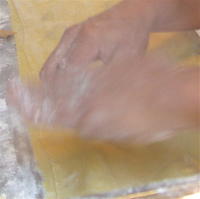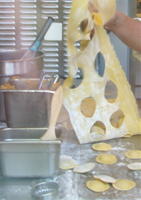Viva Italian - Ravioli
 Placing the meat filling . . .
Placing the meat filling . . . Covering layer . . .
Covering layer . . . Tamping the dough . . .
Tamping the dough . . . Cutting out the pillows . . .
Cutting out the pillows . . . Voila! . . .
Voila! . . .Ravioli - The first memory of ever having this delectable morsel was seeing it come out of a can - Chef Boy - well, you know. Little did my naive young self realize what I was really missing. It is a lot of work, but gadzuks, is it ever worth it! Of course, you can go down to your local pasta house, Italian Deli freezer or Trader J and pick up a few of these lovely pillows, but then you're missing out on all the fun! Think of all the accoutrements you can play with. Bon Apetito!
About Ravioli
Stuffed pasta goes a long way back (Boccaccio mentions ravioli in the Decameron), and almost every region in Italy has its own varieties, with characteristic forms and stuffings. Ravioli, a pasta whose name derives from the verb “to wrap” (ravvolgere), are Ligurian, as are Pansôtti. Tortellini and Cappelletti are Emilian, whereas Agnelotti are from Piemonte.
A century ago stuffed pasta with vegetable-based fillings were eaten on Fridays and in Lent by the well off, and eaten year round by those too poor to buy meat. The meat-stuffed varieties, on the other hand, were a day-after treat made with the left over meats from Sunday dinners or festive meals. Times have changed, and now most Italians buy stuffed pasta ready made.
While you can buy commercially made fresh stuffed pastas in the gourmet sections of many supermarkets (we’ll ignore the stuff sold in cans), there are two advantages to making your own. First, you can choose what to put into your stuffing. A friend of mine who owned a pasta factory told me that he had to leave out some ingredients, like nutmeg, from the tortellini he sold to restaurants because some clients objected to them. Second, pastas stuffed with some of the more exotic fillings are practically impossible to find.
Stuffings for pasta can be either meat, vegetable, or fish-based, and can include a creamy cheese such as ricotta. Specific names should in theory denote specific fillings. For example, as Artusi noted more than a century ago, ravioli should be filled with greens or greens and cheese -- this is because they are Ligurian, and the Ligurian diet was almost exclusively vegetarian, especially inland. However, the word raviolo denotes a shape, and there are a number of meat-based recipes for them.
Agnolotti (Meat Filled)
Agnolotti (pronounced anneeolottee) are Piemontese stuffed pasta, and come in a great many different varieties, some filled with cheese, others meat, and others still meatless. They are, in any case square and small, about 3/4 of an inch to an inch on a side, and are made using very thin sheets of pasta. They also are often made from cooked meat, in other words, leftovers. Recycling can result in something both elegant and very tasty.
INGREDIENTS:
• For the pasta:
• 5 cups flour
• 8 yolks and 2 whites (you want 5 eggs' worth of volume)
• For the filling:
• 12 ounces (300 g) cooked lightly seasoned pot roast
• 8 ounces (150 g) roast pork loin
• 5 ounces (75 g) fresh, mild sausage
• 2 tablespoons unsalted butter
• A bunch of escarole (you can use other greens if need be)
• 1 1/4 cups freshly grated Parmigiano
• 3 eggs
• Freshly grated nutmeg (just a pinch)
• Salt
• For cooking and / or as a sauce:
• Meat broth
• Melted, unsweetened butter (about a half cup, or perhaps a little more)
• Fresh sage
• Freshly grated Parmigiano or Grana Padano
• White truffle, if you're lucky
PREPARATION:
In any case, to serve 6 you'll need the ingredients above.
Make the dough from the flour and the eggs (see instructions if need be), put it in a bowl, cover it with plastic wrap, and let it sit.
While you're kneading the dough bring water to a boil, and boil the sausage and the brains for a few minutes, then remove them and let them cool. Remove the sausage casing and crumble the sausage. Pick over the brain, removing membranes, and mince it.
Blanch the escarole, drain it, squeezing well to extract moisture, and mince it. Then sauté it until done in the butter. Mince the cooked meats quite finely (if need be you can blend them, but be careful not to make a paste). Combine all the ingredients of the filling in a bowl and mix them thoroughly with your fingers to obtain a homogenous mixture, seasoning it to taste with salt, pepper and nutmeg.
Take the pasta dough and roll it out dime-thin. Cut the sheet into two equal-sized pieces, dust one lightly with corn meal, roll it up, and cover it so it stays moist. Dot the half of the sheet still on your work surface with blebs of filling about the size of a small hazelnut, putting the dots in rows that are about an inch apart (I have seen agnolotti that are smaller). Unroll the other sheet, shake off the corn meal, and lay it over the first. Tamp the sheet down well around the filling, so it sticks, and cut the agnolotti free with a serrated pasta wheel.
Come time to cook them, heat the butter in a pan with the sage, and remove it from the flames when the sage begins to whisper (you don't want to brown the butter or burn the sage). In the meantime, bring broth to a boil.
Boil the agnolotti in broth, skimming them off, into a serving bowl, as soon as they rise to the surface. Season them with the butter and sage, and serve with freshly grated cheese, and thinly sliced truffle, if you have it..
Above Adaptation:
From Kyle Phillips,
http://italianfood.about.com


0 Comments:
Post a Comment
<< Home